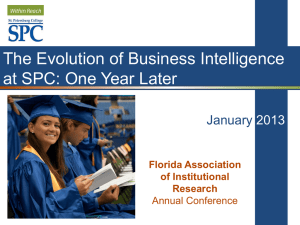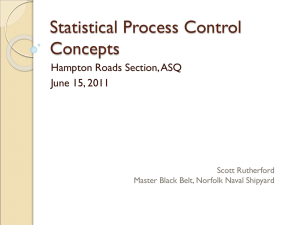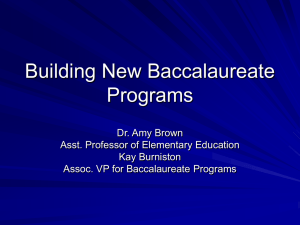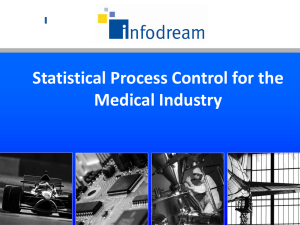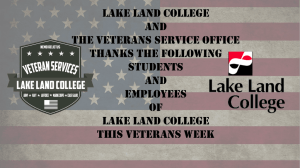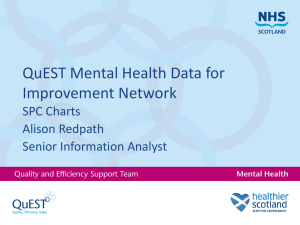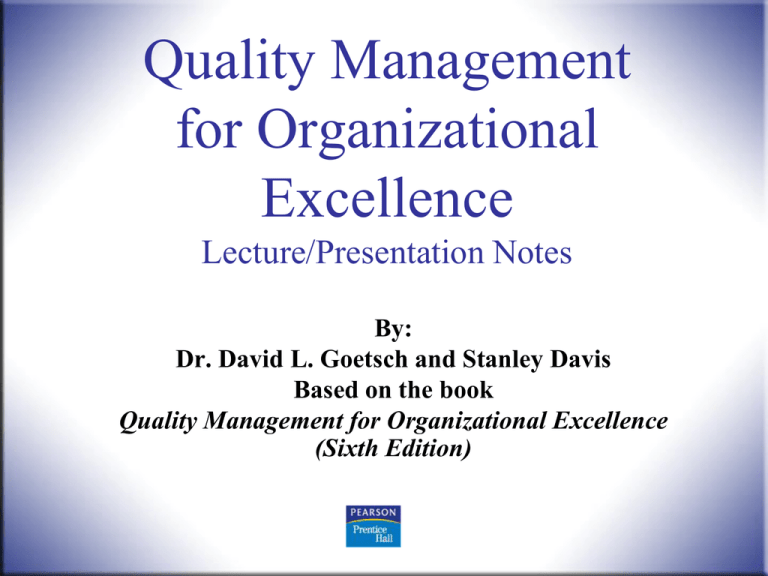
Quality Management
for Organizational
Excellence
Lecture/Presentation Notes
By:
Dr. David L. Goetsch and Stanley Davis
Based on the book
Quality Management for Organizational Excellence
(Sixth Edition)
Quality Management, 6th ed.
Goetsch and Davis
1
© 2010 Pearson Higher Education,
Upper Saddle River, NJ 07458. • All Rights Reserved.
Eighteen:
Optimizing and Controlling Processes through
Statistical Process Control (SPC)
MAJOR TOPICS
Statistical Process Control Defined
Rationale for SPC
Control Chart Development
Management’s Role in SPC
Role of the Total Quality Tools
Authority over Processes and Production
Implementation and Deployment of SPC
Inhibitors of SPC
Quality Management, 6th ed.
Goetsch and Davis
2
© 2010 Pearson Higher Education,
Upper Saddle River, NJ 07458. • All Rights Reserved.
Eighteen:
Optimizing and Controlling Processes through
Statistical Process Control (SPC)
(Continued)
The origin of SPC was in the work of Dr. Walter
Shewhart at Bell Laboratories 1931. Although SPC was
ignored in the West after World War II, Japan adopted
and subsequently developed it into total quality. SPC is
a statistical method of separating special-cause variation
from natural variation to eliminate the special causes
and establish and maintain consistency in the process,
enabling process improvement . SPC is essential in the
West today to elevate the quality of products and
service while lowering costs, to compete successfully in
world markets.
Quality Management, 6th ed.
Goetsch and Davis
3
© 2010 Pearson Higher Education,
Upper Saddle River, NJ 07458. • All Rights Reserved.
Eighteen:
Optimizing and Controlling Processes through
Statistical Process Control (SPC)
(Continued)
A total of 99.73% of the output of a process that
is in statistical control will fall within the ±3σ limits
of the process. Do not confuse process average
and limits with specification average and limits. It
is usually desirable to make the process average
coincident with the specification average and to
make the process spread narrower than the
specification limits.
Quality Management, 6th ed.
Goetsch and Davis
4
© 2010 Pearson Higher Education,
Upper Saddle River, NJ 07458. • All Rights Reserved.
Eighteen:
Optimizing and Controlling Processes through
Statistical Process Control (SPC)
(Continued)
Continual improvement of processes requires that special
causes be eliminated first. Process improvement narrows
the shape of the process’s bell curve, resulting in less
variation.
Continual improvement is a key element of SPC and total
quality. SPC enhances the predictability of processes and
whole plants. Elimination of waste is another key element
of SPC. SPC can help improve product quality while
reducing product cost.
Quality Management, 6th ed.
Goetsch and Davis
5
© 2010 Pearson Higher Education,
Upper Saddle River, NJ 07458. • All Rights Reserved.
Eighteen:
Optimizing and Controlling Processes through
Statistical Process Control (SPC)
(Continued)
SPC makes sampling inspection more reliable. SPC
supports process auditing as a substitute for more
expensive inspection. SPC requires a capability in
statistics, either in-house or through a consultant.
Process operators should be key players in any SPC
program. Understanding the process is a prerequisite
to SPC implementation. All employees involved in SPC
must be trained for their involvement. Measurement
repeatability and reproducibility is essential for SPC.
Quality Management, 6th ed.
Goetsch and Davis
6
© 2010 Pearson Higher Education,
Upper Saddle River, NJ 07458. • All Rights Reserved.
Eighteen:
Optimizing and Controlling Processes through
Statistical Process Control (SPC)
(Continued)
Management’s role in SPC is similar to its role in total
quality overall: commitment, providing training, and
involvement. The seven tools, augmented by flowcharting
and DOX/DOE are required for SPC. SPC and the operator
must have process-stop authority, SPC implementation
must be carried out in an orderly, well thought-out
sequence.
SPC requires collaborative team activity.
Quality Management, 6th ed.
Goetsch and Davis
7
© 2010 Pearson Higher Education,
Upper Saddle River, NJ 07458. • All Rights Reserved.

